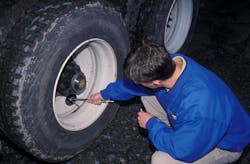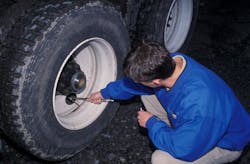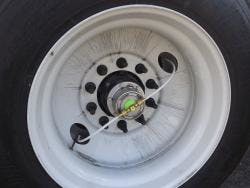Tom Brady and Deflategate shows why tire inflation systems are necessary
So, when you are considered somewhat of a tire expert, and you work for a company that is dedicated to maintaining air pressure inside commercial vehicle tires, regardless of the conditions – hot or cold, highway or off-road – what do you do when the National Football League tries to rewrite the laws of physics? You conduct your own experiment, of course.
Al Cohn, director of new market development and engineering support for Pressure Systems International, makers of the Meritor Tire Inflation System by P.S.I., did just that.
Speaking to customers at P.S.I.’s technology event last week, Cohn spent a few moments debunking the NFL’s investigation of New England Patriots quarterback Tom Brady for allegedly deflating footballs to gain a competitive advantage.
While I don’t want to get into the details of the Deflategate saga - aren’t we all pretty tired (pun intended) of the “scandal”? – I do want to explain Cohn’s investigation and how it ultimately ties back to proper tire inflation on commercial trucks.
For those who don’t know, MTIS by P.S.I. monitors trailer tires and if it detects an underinflated tire will pump air into the tire to keep it properly inflated until it can be repaired.
Back to football for a moment, though. Cohn brought out two identical footballs. As he told the story of his investigation, he noted that he bought four off-the-shelf pressure gauges and then pumped each football up to 13 pounds per square inch (psi). NFL rules require footballs to be between 12.5 and 13.5 psi.
He then used the four gauges to check the pressure of the balls. And you know what? Each gauge gave a different value, Cohn related. No consistency at all.
Then, Cohn took the two footballs and placed them outside in 20 deg. Ohio weather for two hours before bringing them back inside and checking the pressures again. Not so surprisingly, of course, the two footballs measured around 11 psi.
Cohn sent his findings to the NFL in a “nice letter,” as he said, adding that they spent millions to reach a conclusion that is fundamentally wrong (and since disproved by most scientists) and “he would have done the testing for $1,000.”
Consider Deflategate debunked.
So what does all this have to do with trucking? Well, the answer is in the gauge, of course.
As Cohn found with the off-the-shelf gauges, no two gauges are the same. That means that a maintenance tech and driver, each checking the same tire for air pressure, will likely come up with two different readings if they use different gauges. How important is that? With a margin of error of +/- 3 psi, that difference could be significant.
For every 10 psi tires are underinflated, a truck will suffer a 1.5% hit to its fuel economy. Underinflation also leads to irregular tire wear and increased likelihood of punctures, Cohn said. With tires losing between 1 and 3 psi each month simply through osmosis, it becomes vital to maintain proper air pressure.
This ultimately, leads to the whole reason Cohn was speaking to customers of P.S.I., and that was to reinforce the value of a tire inflation system.
One of the things that was learned from the Tom Brady-NFL battle over Deflategate was that the NFL had no specific procedures in place to ensure footballs were properly inflated. Well, truckers do – or at least should.
So, whether you use a tire inflation system or not, it is important to make sure your fleet has procedures in place to regular check tire inflation pressures, especially as winter approaches, since cold weather can be a detriment to inflation pressures – whether the NFL wants to believe it or not.



